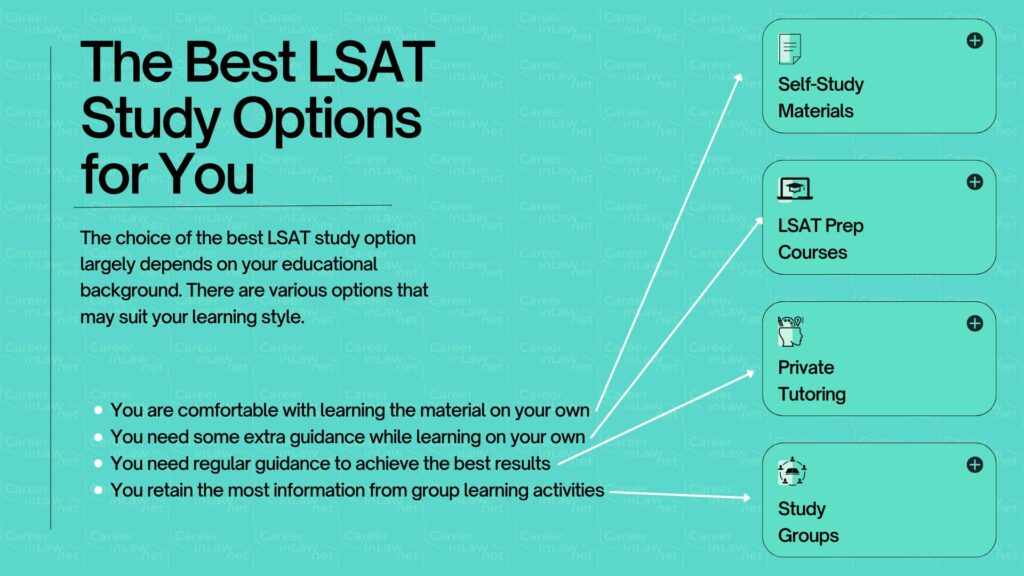In this article, we will explain the best way to study for the LSAT. Without a doubt, there are many avenues for you to explore when choosing how to study for this difficult test. But just like with any test, there is an optimal and the most efficient way that will help you prepare for the test, ace it, and be on your way to becoming a lawyer in Canada! Below, you will learn all about what to study, realistic goal setting, creating a study plan, different study techniques, tips and tricks, and most importantly, how to pass the LSAT.
What to Study for the LSAT
When you are studying for the LSAT, you must understand the test’s structure to give yourself the best chance of passing it. The LSAT consists of 3 sections:
- Logical Reasoning – tests your ability to analyze and evaluate arguments and identify flaws, assumptions, and strengths.
- Analytical Reasoning (also known as Logic Games) – challenges you to make sense of a set of conditions and deduce relationships between elements. (until August 2024)
- Reading Comprehension – tests your ability to read and understand complex texts. You’ll need to identify the main ideas, draw inferences, and compare viewpoints.
Each section requires a unique set of skills and strategies, and you must approach studying for the test by mastering it section by section. It is exactly these 3 sections that you must master in order to score high on the LSAT and get into your top-choice Canadian law school.
The LSAT score system ranges from 120 to 180. Each question carries equal weight, so no question is worth more than the others. There are simply no “easy points” to be gained, and it is crucial to master all question types.
Setting Your LSAT Goals
Setting your LSAT goals starts with determining your baseline score – where your starting point is.
First, you must take a full-length, timed practice test to understand where you stand; this score will be your diagnostic benchmark for your improvement.

Second, set a realistic target score. To do this, research the average LSAT score for the law schools you want to apply to. You can aim high, and the sky is the limit, but please ensure that your target score is attainable.
Third, estimate the time needed to study. Knowing when you will take the LSAT will help you with that. The gap between your benchmark score and your target score will determine how much time you need to prepare. Usually, students spend 3 to 6 months preparing for the LSAT, but this can vary based on individual circumstances.
Here are some guidelines for how long you might need to study based on your target score improvement:
- If you need to improve by 5 points, you may need to study for 2 to 3 months.
- If you need to improve by 10 points, may need to study for 3 to 4 months.
- If you need to improve by 15 points, may need to study for 4 to 5 months.
- If you need to improve by 20 points, may need to study for 5 to 6 months.
Best Ways to Study for the LSAT
The absolute best way to study for the LSAT is to use all possible resources. First, get self-study material. Second, sign up for the LSAT prep course. Third, enrol in private tutoring classes. Fourth, join study groups. If you do all four study options or a combination of them – you will be set for success! However, exactly which options you need to pursue really depends on your benchmark score. One thing for certain, you should never take the LSAT without studying.

Self-Study Materials
Self-study materials are the cornerstone for many LSAT-takers. These are very popular because they allow students to familiarize themselves with test content and practice at their own pace. Self-study materials include:
- Online resources like the Princeton Review offer an array of self-study options that are suitable for every type of learner.
- Prep books from various publishers are ideal for students who are looking to have physical study material.
- Official LSAT prep tests by the Law School Admission Council (LSAC) are a must when looking for any self-study options.
LSAT Prep Courses
LSAT prep courses, both online and in-person, offer structured learning environments and expert guidance. These courses typically provide comprehensive coverage of LSAT content, proven study techniques, and regular practice tests. There are a few types of prep courses:
- In-Person Courses – many companies offer traditional classroom-style courses, which may be an ideal option if you are looking for a well-structured interactive prep course.
- Online Courses – from video lessons to practice tests to personalized feedback, these are ideal of students who are looking for more flexible prep course options.
- Bootcamps – short and intensive courses that aim to boost your score quickly. These may be ideal for someone who needs to revise their skills quickly and get up to speed quickly. However, these courses can be unsuitable for someone who is struggling and needs more time to prepare.
Private Tutoring
Private tutoring can be an effective LSAT study technique if you are looking for personalized attention. Tutors can identify weaknesses, provide targeted strategies, and offer one-on-one support to address individual challenges. Reasons for taking LSAT private tutoring may be that you are looking for:
- 1-on-1 Attention – tutors can provide targeted help in specific areas, whether it’s logical reasoning, logic games, or reading comprehension.
- Flexible Scheduling – private tutors often offer flexible scheduling to fit your availability.
- Expert Insights – tutors with high LSAT scores can share proven techniques for passing the LSAT and achieving a high score.
Study Groups
Study groups offer a collaborative and social approach to LSAT preparation. Discussing complex problems, sharing strategies, and motivating each other can enhance understanding and retention of what you are learning. However, it’s crucial to ensure that group sessions remain focused and productive, as it is easy to derail any study group. Here are some benefits of study groups:
- Collaborative Learning – discussing problems with peers can help deepen your understanding of complex concepts.
- Accountability – regular meetings ensure you stay on track with your study schedule.
- Sharing Resources – group members can share materials, tips, and strategies, enhancing the collective knowledge.
10 Best Techniques and Strategies for LSAT Study
To succeed in the LSAT, it is essential to develop specific strategies for each section and implement effective study techniques. Here are the 10 best ways to master the LSAT:
1- Active Learning Strategy
One effective active learning strategy is to create your own LSAT sections by combining different question types (e.g., one reading comprehension passage, one logic game, and seven logical reasoning questions) into a custom 35-minute drill. This approach exercises all LSAT skills in a single session and encourages active engagement with the material.
2 - Blind Review Method
This approach involves:
- Circling challenging questions during the practice test.
- Reviewing circled questions first, using online forums for explanations.
- Grading the exam and reviewing any additional missed questions.
If you have just started your prep, a more thorough approach is recommended: review every question, understand the reasoning behind each choice, and then grade the test.
3 - Master Time Management Strategies
It's important that you track your progress and adjust study routines based on performance data. This adaptive approach allows for targeted improvement and efficient use of study time.
- Consistent daily practice - aim for at least 30 minutes of focused LSAT study each day.
- Strategic question ordering - through blind review, identify question types that are particularly challenging and plan to tackle these last in timed sections.
- Balanced section practice - alternate between different LSAT section types (Logical Reasoning, Reading Comprehension, and Logic Games) to maintain well-rounded preparation.
4 - Pattern Recognition Techniques
Certain question types and logical structures are repeated quite often on the LSAT. You should create a "pattern bank" to which you can add recurring themes as you practice your logic games and logical reasoning skills. Recognizing logical structures and question types can speed up your ability to answer those questions.
5 - Error Analysis and Review
Thoroughly analyze your mistakes after each practice test or drill. Identify patterns in your errors to focus your study efforts, as it is possible that you are making the same mistake over and over. Keep a log of question types or concepts you consistently struggle with, and dedicate extra time to these areas. Keep track of your failures so you know exactly where you need to improve!
6 - Stress Reduction Techniques
Incorporate mindfulness or deep breathing exercises into your study routine. Practice these techniques during simulated test conditions to manage test anxiety effectively. Consider meditation or light exercise before study sessions to improve focus and reduce stress. Remember that you can be the smartest person out there to take the LSAT, but if you are mentally not ready for it, then you are likely to score low.
7 - Simulating Test Conditions
Regularly take practice tests under conditions that closely mimic the actual LSAT. This includes:
- Using the same start time as your scheduled LSAT
- Wearing similar clothing to what you'll wear on test day
- Practising in a quiet environment with realistic background noise (e.g., page flipping, pencil scratching)
- Using a realistic LSAT proctor (video or audio)
- Taking five-section tests to build stamina
8 - Shine in Your Writing Sample Advice
While unscored, the writing sample shouldn't be neglected. Practice organizing your thoughts quickly and presenting a clear, logical argument. Focus on structure: introduction, body paragraphs with distinct points, and a concise conclusion. Use simple, precise language and avoid unnecessary complexity so that your message is easily understood.
9 - Guessing Strategies
When you find yourself in a situation where random guessing is necessary, strategic and educated guessing can be an effective LSAT technique.
- In Logical Reasoning, you can improve your odds by eliminating obviously wrong answers.
- For Logic Games, if time is running short, quickly sketching out the most restricted game scenario can help you answer multiple questions.
- In Reading Comprehension, when you're stuck, referring back to the passage's topic sentences can provide valuable clues.
10 - Everyday Life Approach
To develop deeper critical thinking, you can cultivate a habit of questioning assumptions in everyday life. When reading news articles or engaging in debates, you can practice identifying premises and conclusions. This skill directly translates to the Logical Reasoning section. Challenge yourself to find flaws in arguments you encounter, mirroring the skills tested on the LSAT.
How to Create an Effective LSAT Study Plan
Look, you need a plan and having a good LSAT study plan can make or break your final score.
First, ensure that your plan balances your study across all sections of the test. Allocate time to each section based on our strengths and weaknesses. You should spend more time on your weakest sections.
Second, you must incorporate practice tests in your study plan. Start with one practice test every two weeks, gradually increasing frequency as your test date approaches. In the final month, aim for two to three full-length practice tests per week under timed conditions.
Third, make sure to follow these LSAT study tips for an effective plan:
- Create a weekly schedule with dedicated study blocks
- Vary your study methods to maintain engagement
- Review mistakes thoroughly to understand underlying concepts
- Use official LSAT materials for the most accurate practice
Top Tip: An effective LSAT study technique is the “spiral approach.” Start by learning foundational concepts in each section, then gradually tackle more complex questions. Regularly revisit earlier material to reinforce your understanding and track improvement.

 Boris Ignachkov
Boris Ignachkov 